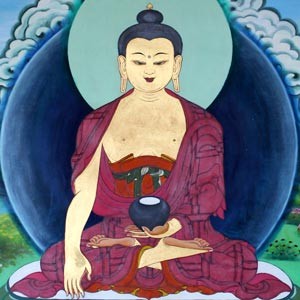
Dzogchen Meditation: An Introduction
Dzogchen teachings (or Dzogpa Chenpo, “Great Perfection”) strip away all concepts about the true nature of consciousness, and give us a practical, direct, blissful path to understanding the true nature of reality – indeed, to the ultimate result of enlightenment. And all this without going through many eons of effort, but within years, or sometimes even months, of practice.
Pristine Awareness
To understand and experience enlightenment, it helps to first understand our fundamental unawareness, which is the root of all the imperfections of our ordinary existence. Unawareness is the non-recognition of our pure, open, unobstructed, innate pristine awareness. Our unawareness gives rise to ordinary mental events – thoughts, feelings, beliefs and perceptual distortions that obscure our pristine awareness.
Ordinary mental events are like clouds in the sky. They gather, proliferate and cover the sky until our view of the clear sky is completely obscured. Similarly, our pristine awareness is obscured by our ordinary mental events. We develop obsessions and aversions, hopes and fears, belief systems and judgments. As mental events grow stronger and stronger, our pristine awareness becomes more and more obscured. Therefore, we cultivate an inner environment of unhappiness, stress, anxiety, fear and turbulent emotions. This is what we call samsara, the endless cycle of temporary joys and sorrows, loving and hating, pleasure and suffering – an unwellness that underlies our entire experience of living and dying.
However, when we recognize our pristine awareness, it’s like the clouds suddenly disappear, revealing the clear sky that was always there. It’s like looking through a clear window and seeing whatever is outside – for instance, the trees outside our window – simply and directly, without anything to block our view. This clear seeing is called “naked awareness” because there are no layers, obscurations or mental events covering or blocking our experience. The pure, open, limitless, brilliant quality of our pristine awareness is sometimes called luminosity. And while samsara is characterized by an underlying unwellness, our pristine awareness is filled to the brim with well-being – tranquility, bliss, clarity and vibrancy, untainted by any conditions or circumstances. It’s natural, just like fire has heat. Isn’t that amazing?
Trekchöd (Trekchöd or Trekchö)
Dzogchen practice has two categories or levels. The first is Trekchod – literally “cutting through” – the path of cutting through, or liberating, our ordinary mental events whenever we want, like a hot knife through butter. In Trekchod, the teacher introduces the student directly to the experience of pristine awareness. The student’s recognition of pristine awareness is the first step.
The student’s next step is meditation – simply, the process of getting more and more familiar with the pristine awareness experience. Meditation begins with letting the body and mind become relaxed, at ease, and alert. Then the meditator naturally and comfortably abides in pristine awareness. As the meditator gets more and more familiar with this experience, the open gap between one thought and the next gets wider and wider, extending for longer and longer periods of time. Ordinary mental events like uncomfortable emotions diminish and dissipate, because they no longer have any support for their appearance. At the same time, extraordinary mental events like unconditional bliss, joy, expansive energy, and compassion arise by themselves – it’s like the cold frozen, bleak winter naturally turning into the rich, ambrosial bloom of spring.
Along with increased experience of extraordinary mental events, comes realization of the essential identity of one’s unbounded awareness and all perceived phenomena, whether of forms, of sounds, or of mental experiences. Both are not only the same, but they also become free from any separate identity. Eventually, pristine awareness becomes the constant abiding state of mind. Whether the practitioner is in formal meditation or engaged in daily living, all forms, all sounds, and all thoughts are instantly liberated upon arising, and appear as nothing other than the radiance of pristine awareness. It’s so natural because it is our true nature!
Tögal (Tögal)
The second level of Dzogchen practice is Togal – “direct crossing” or “leaping over.” With Togal, by mobilizing one’s inherent heart essence wisdom and the awareness accomplished by the practice of Trekchod, the practitioner can shed the encumbrance of the physical body without actually dying, and so attain the ultimate accomplishment: the level of realization called “the naturally present fundamental nature.”
As with Trekchod, Togal requires direct introduction from teacher to student, and the student must attain stability in Trekchod before starting Togal practice. With Togal, the practitioner attains four levels of experience: (1) the direct experience of the nature of reality; (2) the expanding experience of the nature of reality; (3) pristine awareness reaching its ultimate point; and (4) all experience dissolving into the nature of reality.
The Six Bardos
The Dzogchen teachings also include instructions on the Six Bardos. The term “bardo” by itself means simply a state of transition. Typically, it refers only to the time between death and rebirth. In Dzogchen, the bardos are six successive stages of being, each of which provides its own particular opportunity for potential enlightenment. They are:
- The “living bardo” that starts on connection with a new birth, going through one’s lifetime, until the dying process begins;
- The bardo of dreaming, a subset of the living bardo, including the practice of dream yoga;
- The bardo of meditation, another subset of the living bardo, including Dzogchen practice;
- The bardo of the dying process, when the body disintegrates in stages until complete physical death;
- The “bardo of the true nature,” which starts at physical death, when, without the body or mental events in the way, the mind can experience its true nature – but recognition depends on whether pristine awareness has become familiar during lifetime; and
- The “bardo of becoming,” a dreamlike state that produces mental events which direct the consciousness toward rebirth, and continues until the connection with a new rebirth is made and the living bardo begins again.
Lineage
Garab Doje was the first human master of Dzogchen. He is thought to have lived several hundred years after the passing of buddha Shakyamuni. He collected the first Dzogchen instructions, called the Dzogchen Tantras, from the buddha Vajrasattva, who himself received the teachings from the primordial buddha Samantabhadra. The lineage proceeded from Garab Dorje to Manjushrimitra, to Jnanasutra, to Shri Singha; and then to Guru Rinpoche Padmasambhava, Vimalamitra and Vairotsana, who brought the teachings from India to Tibet in the eighth and ninth centuries. The lineage continued to many great Tibetan Dzogchen masters including Dakini Yeshe Tsogyal and the rest of Guru Rinpoche Padmasambhava’s twenty-five main disciples.
For Our Time
The Dzogchen teachings have survived strongly and intact, undiluted and unbroken. Many beings are known to have attained the unsurpassed awakening of enlightenment by the diligent practice of Dzogchen meditation. Some realized masters have even achieved the “rainbow body,” when the physical body dissolves into light, sometimes leaving only hair and nails at death. These teachings are especially important right now – the so-called “degenerate age” in which we live: external conditions of increased war, famine, pandemic and chaos; and especially, internal conditions of increased stress, confusion, anxiety, fear, and distorted perception. We are so fortunate to have these wonderful, beautiful teachings for our ultimate liberation, in this very lifetime!
To view additional Dzogchen teachings from meditation master Orgyen Chowang Rinpoche, subscribe to our YouTube channel.



